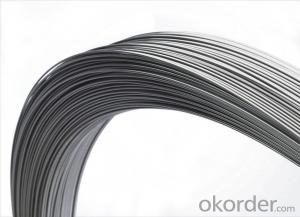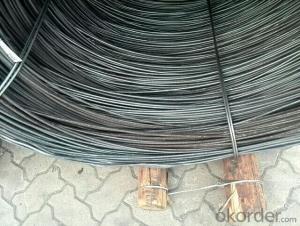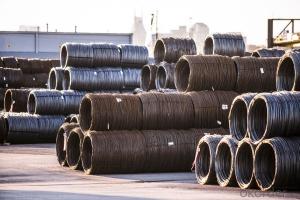SAE1006Cr Carbon Steel Wire Rod 16mm for Welding
- Loading Port:
- Shanghai
- Payment Terms:
- TT OR LC
- Min Order Qty:
- 100 m.t
- Supply Capability:
- 30000 m.t/month
OKorder Service Pledge
OKorder Financial Service
You Might Also Like
Specification
Description of SAE1006Cr Carbon Steel Wire Rod 16mm for Welding:
OKorder is offering Color Coated Steel Coil Prepainted Steel Coil at great prices with worldwide shipping. Our supplier is a world-class manufacturer of steel, with our products utilized the world over. OKorder annually supplies products to European, North American and Asian markets. We provide quotations within 24 hours of receiving an inquiry and guarantee competitive prices.

Applications of SAE1006Cr Carbon Steel Wire Rod 16mm for Welding:
Color Coated Steel Coil Prepainted Steel Coil are ideal for structural applications and are widely used in the construction of buildings and bridges, and the manufacturing, petrochemical, and transportation industries.
Main Product Features of SAE1006Cr Carbon Steel Wire Rod 16mm for Welding:
· Premium quality
· Prompt delivery & seaworthy packing (30 days after receiving deposit)
· Corrosion resistance
· Can be recycled and reused
· Mill test certification
· Professional Service
· Competitive pricing
Specifications of SAE1006Cr Carbon Steel Wire Rod 16mm for Welding:
1, Introduction: Color coated steel coils(sheets), i. E. PPGI, also called prepainted steel coils(sheets), are made of galvanized steel coils(sheets) with polymer coatings as surface. It's a new enclosure material and building board with characteristics of light-weighted, heat preserved&insulated, easily installed with bright colors.
2, Production Process: Pretreatment(Degreasing)_Drying_Chromating_Paint Basic Oil_Cooling_Drying_Color Coating_Cooling_Film-covering_Rolling Up
3, Characteristics:
Good at corrosion resistence. Besides zinc coating of the basic plate of galvanized steel sheet, the color coating as the surface has double lifetime to ensure better anticorrosion effect.
With excellent cold bending molded manufacturablity, PPGI products can be processed or directly used as final product. As being light-weighted and conveniently transported, they're widly used to replace wood to save energy.
4.There're thousands of colors can be chosen as per different application. Any color plays well in decoration.
No pollution with high recycling rate, PPGI coils and sheets are strongly recommended as enviroment-friendly products by the government.
5, eye bands and 4 circumferential bands in steel, galvanized metal fluted rings on inner and outer edges, galvanized.
| commodity | SAE1006Cr Carbon Steel Wire Rod 16mm for Welding |
| Techinical Standard: | JIS G3302-1998, EN10142/10137, ASTM A755 |
| grade | Q195,Q215,Q235,SAE1006,SAE1008 SAE1006Cr |
| Types: | Mesh welding |
| Base metal | galvanized, galvalume, cold rolled steel |
| Thickness | 0.14-1.0mm(0.16-0.8mm is the most advantage thickness) |
| Width | 610/724/820/914/1000/1200/1219/1220/1250mm |
| Type of coating: | PE, SMP, PVDF |
| Zinc coating | Z60-150g/m2 or AZ40-100g/m2 |
| Top painting: | 5 mic. Primer + 15 mc. R. M. P. |
| Back painting: | 5-7 mic. EP |
| Color: | According to RAL standard |
| ID coil | 508mm610mm |
| Coil weight: | 2--3MT |
| Package: | Properly packed for ocean freight exportation in 20'containers |
| Application: | Industrial panels, roofing and siding for painting/automobile |
| Price terms | FOB, CFR, CIF |
| Payment terms | 20%TT in advance+80% TT or irrevocable 80%L/C at sight |
| delivery time | 25 days after recepit of 20% TT |
| Remarks | Insurance is all risks |
| MTC 3.1 will be handed on with shipping documents | |
| We accept SGS certificatation test |

FAQ of SAE1006Cr Carbon Steel Wire Rod 16mm for Welding:
Q1: Why buy Materials & Equipment from OKorder.com?
A1: All products offered byOKorder.com are carefully selected from China's most reliable manufacturing enterprises. Through its ISO certifications, OKorder.com adheres to the highest standards and a commitment to supply chain safety and customer satisfaction.
Q2: How do we guarantee the quality of our products?
A2: We have established an advanced quality management system which conducts strict quality tests at every step, from raw materials to the final product. At the same time, we provide extensive follow-up service assurances as required.
Q3: How soon can we receive the product after purchase?
A3: Within three days of placing an order, we will begin production. The specific shipping date is dependent upon international and government factors, but is typically 7 to 10 workdays.
Q4: What makes stainless steel stainless?
A4: Stainless steel must contain at least 10.5 % chromium. It is this element that reacts with the oxygen in the air to form a complex chrome-oxide surface layer that is invisible but strong enough to prevent further oxygen from "staining" (rusting) the surface. Higher levels of chromium and the addition of other alloying elements such as nickel and molybdenum enhance this surface layer and improve the corrosion resistance of the stainless material.
Q5: Can stainless steel rust?
A5: Stainless does not "rust" as you think of regular steel rusting with a red oxide on the surface that flakes off. If you see red rust it is probably due to some iron particles that have contaminated the surface of the stainless steel and it is these iron particles that are rusting. Look at the source of the rusting and see if you can remove it from the surface.
- Q: How are steel wire rods used in the manufacturing of tire reinforcements?
- Steel wire rods are used in the manufacturing of tire reinforcements by being embedded in rubber to enhance the strength, durability, and stability of tires. These rods provide structural support and help to resist deformation, improve traction, and increase the overall performance and safety of tires.
- Q: What are the common applications of cold heading quality and oil tempered steel wire rod?
- The common applications of cold heading quality steel wire rod include the manufacturing of fasteners such as bolts, screws, and rivets. It is also used in the production of automotive parts, machinery components, and construction materials. Oil tempered steel wire rod, on the other hand, finds its common applications in springs, suspension systems, and other high-strength and high-performance applications where resistance to fatigue and durability are important factors.
- Q: How is the grain size of steel wire rod measured?
- The grain size of steel wire rod is typically measured using a method called metallography. Metallography involves preparing a sample of the steel wire rod by cutting it into a small piece and then grinding and polishing it to obtain a smooth surface. Once the surface is prepared, the sample is etched with a chemical reagent to reveal the grain boundaries. The etching process helps to distinguish individual grains and makes them more visible under a microscope. After etching, the sample is observed under a microscope at high magnification. The grains are counted, and their size is measured using a measuring reticle or software. The grain size is usually reported as an average grain diameter or a grain size number, which corresponds to the number of grains per unit area. It is important to note that the measurement of grain size is subjective and can vary depending on the observer's interpretation. Therefore, it is common to use standardized methods, such as ASTM E112 or ISO 643, to ensure consistency and accuracy in grain size measurements. These standards provide guidelines on sample preparation, etching procedures, and grain size determination.
- Q: What are the different types of heat treatments used for steel wire rod?
- There are several types of heat treatments used for steel wire rods, each with its own purpose and benefits. Some of the most commonly used heat treatments include: 1. Annealing: This process involves heating the steel wire rod to a specific temperature and then slowly cooling it to improve its ductility and reduce internal stresses. Annealing also helps to refine the microstructure of the steel, making it easier to work with and enhancing its mechanical properties. 2. Quenching and tempering: Quenching is the rapid cooling of the steel wire rod after heating it to a high temperature. This process results in a hardened steel with increased strength and hardness. Tempering is then performed by reheating the quenched steel to a lower temperature to reduce brittleness and improve toughness while maintaining some of the hardness achieved during quenching. 3. Normalizing: Similar to annealing, normalizing involves heating the steel wire rod to a specific temperature and then allowing it to cool in still air. This process helps to refine the grain structure of the steel, improve its strength and toughness, and eliminate any internal stresses. 4. Stress relieving: This heat treatment is performed to reduce residual stresses that may have accumulated in the steel wire rod during previous manufacturing processes. By heating the rod to a specific temperature and then cooling it slowly, stress relieving helps to prevent distortion or cracking of the material. 5. Case hardening: Also known as carburizing, this heat treatment involves introducing carbon into the surface layer of the steel wire rod to increase its hardness and wear resistance. The rod is heated in the presence of a carbon-rich atmosphere and then quenched to achieve the desired hardness. Overall, the choice of heat treatment for steel wire rods depends on the desired properties and applications of the final product. Each treatment method has its own advantages and is selected based on the specific requirements of the wire rod.
- Q: What are the standard fatigue resistance requirements for steel wire rod?
- The standard fatigue resistance requirements for steel wire rod vary depending on the specific application and industry standards. However, common fatigue resistance requirements for steel wire rod include meeting certain endurance limits, fatigue strength, and fatigue life expectations specified by the relevant standards organization or customer specifications. Additionally, factors such as the wire rod's diameter, surface condition, and chemical composition can also impact its fatigue resistance.
- Q: How are steel wire rods used in the manufacturing of wire brushes?
- Wire brushes rely on steel wire rods as a vital ingredient in their production. These rods act as the foundation for the brush's bristles. The first step involves drawing the steel wire rods through a series of dies to decrease their diameter and increase their length. This process, known as wire drawing, ensures that the wire attains the desired thickness and strength necessary for the brush's bristles. Once the wire has been drawn, it is then cut into specific lengths based on the brush's size. These cut lengths are then inserted into the brush's base, typically made of wood or plastic, and secured in place using various techniques like stapling or twisting. The steel wire rods utilized in wire brushes are generally crafted from high-quality carbon steel, which offers the necessary durability and flexibility for efficient brushing. Furthermore, the wire is frequently coated with a layer of protective material, such as zinc or brass, to prevent corrosion and enhance its lifespan. The bristles made from steel wire rods find extensive usage in a variety of industries and applications. Wire brushes with steel bristles are commonly employed for cleaning, deburring, polishing, and surface preparation tasks. They excel in removing rust, paint, and other stubborn residues from metal surfaces. The strength and resilience of steel wire bristles make them suitable for heavy-duty cleaning and abrasive tasks. To summarize, steel wire rods are essential in the production of wire brushes as they serve as the raw material for the bristles. Through processes like wire drawing, cutting, and securing, these rods are transformed into durable and efficient bristles that are widely utilized in multiple industries for cleaning and surface preparation purposes.
- Q: What are the standard specifications for steel wire rod?
- The steel wire rod's standard specifications differ depending on the industry and specific application. However, there are commonly followed general standards and specifications. The American Society for Testing and Materials (ASTM) standard is the most widely used standard for steel wire rod. The ASTM A510/A510M standard specifies the general requirements for wire rods and coarse round wire, carbon steel. It covers various aspects such as chemical composition, mechanical properties, dimensions, and tolerances. Regarding chemical composition, the standard sets maximum limits for carbon, manganese, phosphorus, and sulfur content. These limits ensure that the steel wire rod possesses the necessary strength, ductility, and other mechanical properties. The standard also specifies the mechanical properties of the steel wire rod, including minimum yield strength, tensile strength, and elongation. These properties determine the wire rod's ability to withstand applied forces and deformation without breaking or failing. Additionally, the standard outlines the dimensions and tolerances for the steel wire rod, including diameter, length, and straightness. It provides guidelines for acceptable deviations from the specified dimensions to ensure consistency and quality. Apart from the ASTM standard, specific industries may follow their own standards based on the intended application of the steel wire rod. These industry-specific standards may include additional requirements or properties relevant to the specific industry or application. In summary, the standard specifications for steel wire rod cover various factors such as chemical composition, mechanical properties, dimensions, and tolerances. These specifications guarantee that the steel wire rod meets the necessary quality and performance standards for its intended use.
- Q: What are the different production processes for steel wire rod?
- There are several different production processes for steel wire rod, including the electric arc furnace (EAF) process, the basic oxygen furnace (BOF) process, and the direct reduction process. In the EAF process, scrap steel is melted in an electric arc furnace, and alloying elements are added to achieve the desired composition. The molten steel is then continuously cast into billets, which are subsequently rolled into wire rod. The BOF process involves melting iron ore in a basic oxygen furnace, where oxygen is blown into the molten metal to remove impurities and adjust the composition. The resulting steel is likewise cast into billets and rolled into wire rod. The direct reduction process, on the other hand, utilizes natural gas or coal to convert iron ore into direct reduced iron (DRI). The DRI is then melted in an EAF and processed into wire rod. These different production processes allow for flexibility and enable manufacturers to produce wire rod with varying properties to meet specific customer requirements.
- Q: How is steel wire rod used in the manufacturing of fishing hooks?
- Steel wire rod is used in the manufacturing of fishing hooks as it provides the necessary strength and durability required to withstand the tension and pressure exerted while catching fish. The wire rod is shaped and cut into various sizes to form the hooks, ensuring they can securely hold bait and withstand the pulling force when a fish is hooked.
- Q: What are the national standards for steel wire rod?
- The national standards for steel wire rod vary from country to country, as each country has its own set of regulations and requirements for the production and quality control of steel wire rod. These standards typically cover aspects such as chemical composition, mechanical properties, dimensions, tolerance levels, testing methods, and packaging. It is important for manufacturers and suppliers to adhere to these national standards to ensure the safety and reliability of steel wire rod products in their respective markets.
Send your message to us
SAE1006Cr Carbon Steel Wire Rod 16mm for Welding
- Loading Port:
- Shanghai
- Payment Terms:
- TT OR LC
- Min Order Qty:
- 100 m.t
- Supply Capability:
- 30000 m.t/month
OKorder Service Pledge
OKorder Financial Service
Similar products
Hot products
Hot Searches
Related keywords































